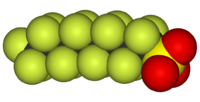
Photo from wikipedia
Several hypotheses have been proposed to explain the comorbidity between psychotic disorders and substance use, one of them being the capacity of some to induce psychotic symptoms, although the transition… Click to show full abstract
Several hypotheses have been proposed to explain the comorbidity between psychotic disorders and substance use, one of them being the capacity of some to induce psychotic symptoms, although the transition from psychotic episodes induced by substances to schizophrenia has been less studied. In this study, differential variables between patients with induced and non-induced psychosis are determined, and the evolution and change of diagnosis of those induced to schizophrenia in the follow-up is analyzed. This is an observational case-control study with 238 patients admitted to the acute care unit for psychotic episodes between December 2003 and September 2011. The group of non-substance-induced psychotic disorders (NSIPD) included 127 patients, with 111 in the substance-induced (SIPD) group, according to the International Classification of Diseases. Sociodemographic and clinical characteristics, personal and family history, substance use, diagnostic stability and progression were compared. The NSIPD group showed higher scores in severity and in negative symptoms and more family history of psychosis. The SIPD group presented more personal history of personality disorder and family history of addictions and more positive symptoms At 6 years of follow-up, 40.9% of ISDP changed to a diagnosis of schizophrenia, presenting more family history of psychotic disorders and worse progression with more visits to the emergency department and readmissions, than subjects who maintained diagnostic stability. Therefore, special attention should be paid to this group of patients because of the potential severity and the increased risk of developing a chronic psychotic disorder.
Journal Title: Adicciones
Year Published: 2023
Link to full text (if available)
Share on Social Media: Sign Up to like & get
recommendations!